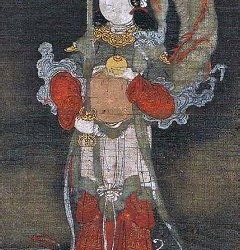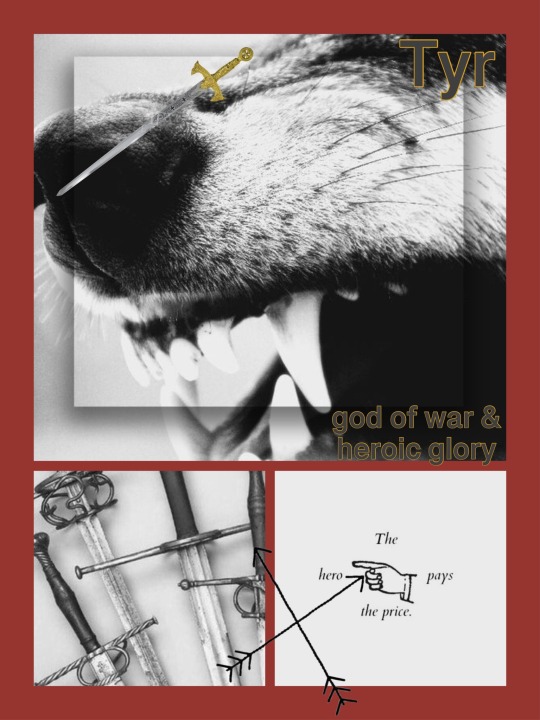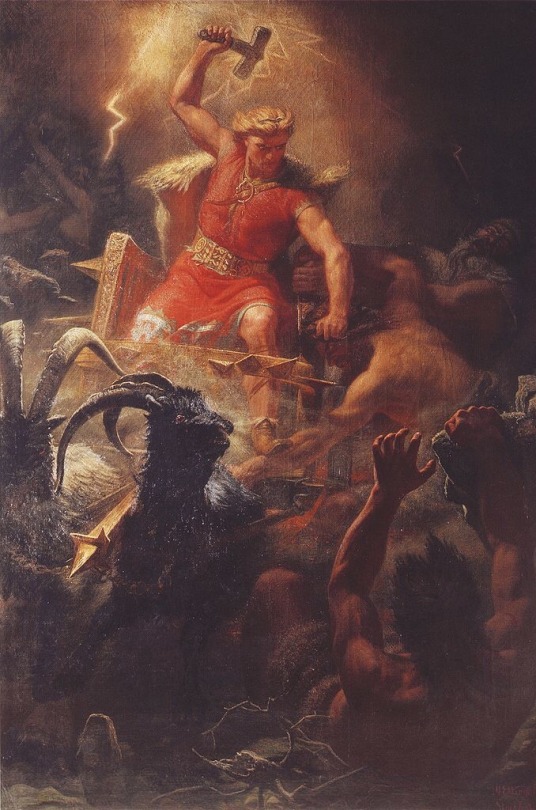Text
The Battle of Perun & Veles (Basically)
Thank you for 200 followers! I’m very sorry for the delay, school’s been intense recently and I haven’t had the time to do the research needed for this post. In any case, I hope you enjoy this one; you’ll get another myth retelling once I reach 250!
IIIIN THIS CORNER WE HAVE PERUN, GOD OF THE SKY AND EARTH, LORD OF THE GODS.
AAAND IN THIS CORNER WE HAVE VELES, GOD OF THE WATER AND UNDERWORLD, AND YOU KNOW HE’S A TRICKSTER.
These guys are pretty heavy hitters in the Slavic pantheon, so this battle between the two of them is kind of a big deal.
What starts all this is Veles stealing something of Perun’s. Whether it’s his cattle, wife, or children, we’re not sure. Regardless, Perun is mad.
ROUND 1, FIGHT
So, he chases Veles all around the world trying to zap him with lightning bolts (because every supreme god has lightning bolts for some reason), but Veles manages to dodge his attacks by transforming into animals or hiding behind trees, buildings, or people.
He isn’t able to evade Perun forever though. Eventually, Perun either kills Veles or manages to banish him back to the underworld (and, I assume, get his stuff/family back).
TOTAL KNOCKOUT
To the Slavic people at the time, this story symbolized the conflict between order and chaos, and how the good always ends up on top. In other words, they lived happily ever after.
4 notes
·
View notes
Photo



In Aztec mythology, Coatlicue (”she with serpent skirts”) is the mother of the 400 stars in the sky, and one daughter, Coyolxauhqui (”she with bells on her cheeks”). When Coatlicue becomes pregnant illegitimately (by touching a tuft of hummingbird feathers - this sort of stuff happens a lot in Mesoamercan mythos), her children become both embarrassed and enraged. But none more so than her daughter, Coyolxauhqui. Together with her 400 brothers, she launches an attack on her mother, but it is foiled when her mother’s unborn son Huitzilopochtli (”the hummingbird on the left”) springs forth from her womb, armed for battle.
Huitzilopochtli dismembers Coyolxauhqui, and flings her head into the sky where it becomes the moon, so that her mother might look upon her always.
18K notes
·
View notes
Text
Bata
Origin: Egyptian
God of: The 17th Upper Egyptian Nome, called Input
Popularity: Semi-Obscure
Relationships: Associated with Anubis, the other patron god of Input.
Depiction: Until around halfway through the Eighteenth Dynasty, he was depicted as a ram. Then, depictions of him transitioned into a bull.
2 notes
·
View notes
Text
Darvi
Origin: Melanesian
God/Spirit of: Creation
Popularity: Very Obscure
Relationships: Associated with the Demas, creator spirits that he is the leader of.
4 notes
·
View notes
Text
Khrut

Origin: Thai
God of: The Sun
Popularity: Very Popular
Depiction: He is depicted as a large being that is half bird, half man. He has the head, beak, wings, and talons of an eagle, with the torso of a human man.
Worship: He is the national emblem of Thailand, and a seal of him is used by government officials to certify documents.
5 notes
·
View notes
Text

#mythology#gods#fertility#aesthetic#moodboard#aesthetic edit#greek#greek mythology#greek gods#nature#the wild#shepherds#hunting#rustic#music#fields#groves#forests#woodlands#animals#sexuality#nature god#fertility god#mythology aesthetic#mythology moodboard#greek mythology aesthetic#greek god aesthetic
4 notes
·
View notes
Text
Umay/Umai/Omay/Imay/Ubay/Humay
Origin: Turkic/Siberian/Mongolian
Goddess of: Fertility & Virginity
Popularity: Semi-Popular
Relationships: Daughter of Tengri, Sister of Erlik, Koyash, Ay Tanri, & Ülgen
Depiction: She is depicted with sixty golden locks of hair that appear like rays of the sun, and is almost always show with a child. She also occasionally takes the form of a deer
Epithets: Yellow Maiden, Mother Umay
Worship: Important women in the Mongol empire were equated to Umay; Women who worship Umay are believed to have male children; It is thought that if Umay stops caring for a child, that would cause it to get ill. When this happens, shamans are called to help bring Umay back; A happy, sleeping baby means Umay is near, and a crying baby means Umay is gone; Some believe that Umay also gives good luck.
#mother goddess#earth goddess#protector goddess#fertility#virginity#earth#protection#women#children#fertility goddess#turkic#turkic mythology#turkic goddesses#siberian goddesses#siberia#siberian#siberian mythology#mongolia#mongolian#mongolian mythology#mongolian goddesses
20 notes
·
View notes
Text
Zennyo Ryuo/Zennyo Ryūō/Zenmyo/Zennyo/Zentatsu

Origin: Buddhist (Japanese)
God(dess) of: Rain
Popularity: Semi-Popular
Depiction: (S)he is depicted as a small dragon or a small, golden snake riding on the head of a dragon. Sometimes, (s)he takes the form of a male or female with a dragon’s tail.
Worship: (S)he was believed to live in a cave called Ryūketsu on Mount Murō in the Nara prefecture of Japan. In ancient times, this cave was a common setting for worship and rainmaking ceremonies; Whenever there was a drought, buddhist priests would pray and conduct ceremonies in honor of Zennyo, and it was said that rain would come without fail; There is also a shrine dedicated to him/her in Kyoto, called Shinsen’en.
#mythology#goddesses#gods#japanese#japan#japanese mythology#buddhist#japanese buddhist#buddhist mythology#japanese goddesses#japanese gods#dragon#dragons#rain
24 notes
·
View notes
Text
Uma/Umā
Origin: Hindu
Goddess of: The Mountains, Light, & Beauty
Popularity: Semi-Popular
Relationships: Daughter of Himavat & Mena, Sister of Ganga, Wife of Shiva, Associated with Parvati, Durga, Gauri, Sati, & Aparna (her other forms)
Depiction: She was depicted as a beautiful mediator of conflicts between other deities.
Epithets: Lady of the Mountains
Worship: She and her other forms are depicted widely in sculptures, on coins, and in literature from India and beyond.
3 notes
·
View notes
Text

#I’m back!#sort of#mythology#goddesses#norse#norse mythology#moodboard#aesthetic#norse mythology aesthetic#goddess aesthetic#agriculture#agricultural goddess#agriculture aesthetic#plant aesthetic#farm aesthetic#aesthetic edit#collage
13 notes
·
View notes
Text

#I’m not dead#just busy and not motivated#when school starts back and I get back on my stimulant I’ll be back I swear
50K notes
·
View notes
Text
Mara/Māra/Māras Māte/Māre/Mārīte/Mārasmate/Mārša/Māršava/Piena-Mate/Lopu Mate/Iopu Marija
Origin: Latvian
Goddess of: Milk Production & Protection
Popularity: Popular
Relationships: Associated with Moschel & Laima (childbirth goddess)
Epithets: Mother of the Milk & Mother of Livestock
Worship: She had a festival dedicated to her called Māras, which took place on August 15th; A symbol called “Māra’s cross” was often placed on fresh-baked bread & fireplaces to dedicate them to her as offerings & earn her blessing.
#mythology#goddesses#mother goddess#latvia#latvian#latvian mythology#latvian goddesses#protector goddess#cow#milk#production#water#rivers#seas#protection
2 notes
·
View notes
Text
Hypnos/Hypnus

Origin: Greek
God of: Sleep
Popularity: Semi-Popular
Relationships: Son of Nyx (& Erebus, according to some sources), Brother of Thanatos, Nemesis, Eris, The Keres, Apate, The Moirai, Oizys, Momus, Aether, Hemera, Moros, Dolos, Philotes, & Geras, Husband of Pasithea, Father of The Oneiroi
Depiction: A young man with wings on his head, sometimes appropriately shown sleeping. He is described as a kind & gentle god with a good relationship with humans, but is sometimes known to trick people, especially Zeus.
Worship: The word “hypnosis” comes from his name; There are many works of art depicting him, especially vases.
27 notes
·
View notes
Text
Völuspá - Stanzas 1-20
The Norse Creation Myth from the Poetic Edda (Basically)
Thank you all sooo much for 150 followers!!
Since you all seem to like my Norse content so much, here’s my satirical retelling of Völuspá stanzas 1-20. Hope you enjoy~!
So Völuspá is told by a völva, which is kind of like an oracle or a prophet, to Odin - against her will, unsurprisingly. It covers a lot of different topics from past, present, & future, but we’re just going to cover the first section today.
It starts off with the völva basically telling everyone to be quiet and listen up, which is understandable because this story is long and she’s not gonna repeat it. (I guess I’m kind of acting as the völva in this situation.)
At first, there was nothing - how most creation myths start. It was just Ymir chillin’ out in the void. Then, out of nowhere, Bur’s sons (Odin, Vili, & Ve) came and lifted up Mithgarth, which would become the land of humans. Leeks started to grow, which sounds totally random but apparently they were symbolic of growth and said to have magic power.
The Sun, Moon, and stars appeared, but didn’t really know what to do or where to go. But I guess the gods (Æsir) figured that out for them, because they were here now.
The Æsir held a council, and built some stuff, like places for them to live. And they had a great time, chillin’ out again, until three awesome giant ladies rolled up from Jotunheim. It doesn’t really explain why the giantesses caused problems, but generally Aesir and Jötnar don’t really get along.
Afterwards came the creation of the dwarves, from the blood and limbs of (presumably) Ymir :( What did Ymir do wrong y’all why’d you kill him :(
Anyway, Motsognir was the mightiest of all the dwarves, and Durin was second to him. After that, the völva goes on to list a whole lot of dwarf names for no particular reason—maybe just to waste everyone’s time.
Then come humans: Ask & Embla. They were empty shells, with no soul or senses(or common sense I’m not sure which), or whatever “heat” and “goodly hue” means. So, Odin gave them souls, Hönir gave them senses, and an early version of Loki gave them their heat and goodly hue.
The destinies of humans were cut into the wood of the world-tree by the Norns, goddesses of fate, and then…the war between the Æsir and the Vanir—the first war ever, in fact. But that’s a story for another day.
12 notes
·
View notes
Text

#mythology#gods#norse#norse mythology#norse gods#law#justice#war#combat#victory#heroic#glory#war god#moodboard#aesthetic#aesthetic edit#norse mythology aesthetic#norse god aesthetic#mythology aesthetic
8 notes
·
View notes
Text
The Juni Shinsho/Jūni Shinnō/Juni-Shinsho/Jūni Yakusha Taishō/Twelve Divine Generals/Twelve Heavenly Generals

Origin: Buddhist (Japanese)
Deities of: Protection
Popularity: Semi-Obscure
Relationships: Associated with the Yakushi Buddha (healing buddha)
Worship: Statues of them were created and placed in temples, usually accompanied by a central Buddha figure.
#mythology#buddhist#buddhism#japan#japanese#japanese mythology#buddhist mythology#japanese buddhist#japanese buddhism#protection#protector deities
14 notes
·
View notes
Text
Thor/Donar/Thunor/Thórr

Origin: Norse
God of: Thunder & Protection
Popularity: Very Popular
Relationships: Son of Odin and Jörd, Husband of Sif, Father of Magni, Modi, & Thrud
Depiction: Thor is depicted as a muscular blond or red-haired & bearded man wielding a hammer. He rides a cart or chariot pulled by two goats. He is known as a brave, fierce warrior with unbelievable strength.
Epithets: The Terrible, The Bear, The One Who Rides Alone, Brave Heart, Fierce Soul, & The Thunder Hurler
Worship: The weekday Thursday was named after him; His hammer was symbolic of the god, and was displayed in many different ways, including amulets and on runestones; From the Viking Age onward, personal names stemming from Thor were common; He had a temple, and priests were appointed to offer him sacrifices in an effort to prevent plague or famine; Even after the Christianization of Europe, Thor continued to be invoked and worshipped by many people of Northern & Western Europe.
#mythology#gods#norse#norse mythology#norse gods#lightning#thunder#storms#trees#strength#protection#fertility#protector god#fertility god
57 notes
·
View notes